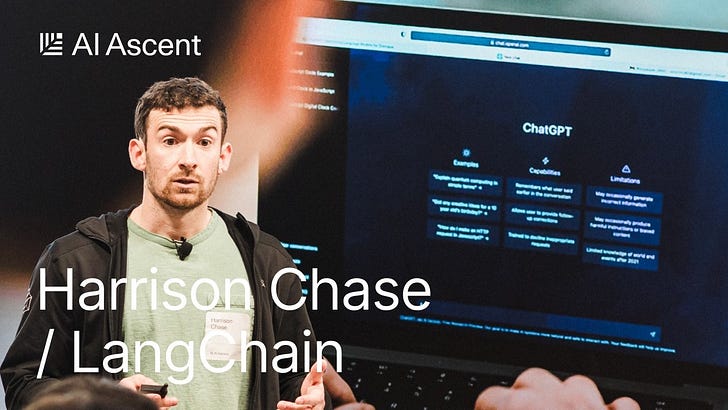Ambient Agents and the New Agent Inbox ft. Harrison Chase
LangChain CEO Harrison Chase introduces ambient agents that operate continuously in the background.
Post methodology: Dust custom assistant @AIAscentEssay using Claude 3.7 with system prompt: Please take the supplied transcript text and write a substack-style post about the key themes in the talk at AI Ascent 2025. Style notes: After the initial mention of a person, use their first name for all subsequent mentions; Do not use a first person POV in the posts. Light editing and reformatting for the Substack editor.At AI Ascent 2025, Harrison Chase, Co-Founder and CEO of LangChain, unveiled a compelling vision for the future of AI agents that extends far beyond the chat interfaces we've grown accustomed to. His talk explored the concept of "ambient agents" – AI systems that operate continuously in the background, responding to events rather than direct human prompts.
Beyond the Chat Interface
While chat-based AI assistants have become ubiquitous, Harrison argues they represent just the beginning of what's possible. The key limitation of chat agents is their inherently reactive nature – they only respond when directly engaged by a human user in a largely 1:1 interaction model.
Ambient agents, by contrast, operate on a fundamentally different paradigm:
Event-driven: They respond to background events rather than explicit human messages
Scalable: Multiple ambient agents can run simultaneously, potentially thousands at once
Relaxed latency requirements: Since they run in the background, they can execute more complex operations without the pressure of immediate response times
Complex operations: They can call multiple tools and incorporate explicit planning or reflection steps
To make this concept concrete, Harrison described an email agent that continuously monitors incoming messages and takes appropriate actions – responding to messages, scheduling meetings, or alerting team members when necessary. This represents just one of many potential applications for ambient agents.
Human-in-the-Loop Remains Essential
Perhaps the most important insight from Harrison's talk was his emphasis that "ambient does not mean fully autonomous." Despite operating in the background, these agents still require human oversight and interaction, just in different forms. He outlined several critical interaction patterns:
Approval/rejection: Humans reviewing and authorizing agent-proposed actions
Editing actions: Modifying agent suggestions rather than simply accepting or rejecting them
Answering questions: Providing guidance when agents encounter uncertainty
Time travel: The ability to revisit earlier steps in an agent's decision process and provide feedback
These human touchpoints serve multiple purposes – they improve results, build trust, and perhaps most interestingly, provide essential training data that helps agents learn from user interactions.
The Agent Inbox: A New UX Paradigm
One of the most intriguing aspects of Harrison's presentation was the introduction of the "agent inbox" concept – a dedicated interface where humans can review and interact with ambient agent activities. This represents a fascinating evolution in how we might manage relationships with multiple AI assistants working on our behalf.
LangChain has developed this concept as a prototype, creating an interface that displays agent activities requiring human attention along with detailed descriptions and various interaction options.
Building the Infrastructure
Harrison also shared insights into how LangChain is developing the technical infrastructure to support ambient agents through several key components:
LangGraph: Their agent orchestration framework with robust persistence capabilities
LangGraph Platform: Infrastructure specifically designed for running ambient agents at scale
LangSmith: Tools for visibility and observability into agent operations
As proof of concept, Harrison revealed he's been using an ambient email agent for over a year. This open-source tool drafts responses and sends calendar invites while maintaining human oversight through the agent inbox interface. This practical application demonstrates the potential of ambient agents in everyday productivity contexts.
Related: “Goldilocks” Agents and the Power of Custom Cognitive Architectures
The Future of Human-AI Collaboration
Harrison's vision points toward a future where AI assistance extends far beyond chatbots into a network of specialized ambient agents handling various tasks in the background. This represents a significant evolution in how we might interact with AI systems – less through direct conversation and more through periodic supervision and guidance.
The ambient agent model could dramatically expand our ability to leverage AI by removing the bottleneck of direct human interaction while maintaining appropriate human oversight. It's a vision that balances autonomy with accountability in a way that feels both powerful and responsible.
Related:



